Project in the Business Area: Photovoltaics, Topic: Perovskite- and Organic Photovoltaics, Perovskite Solar Cells and Modules Duration: 09/2019 - 08/2022
more infoResearch Projects
-

For the development of printed perovskite solar cells, optimization of the electrode structures, perovskite photoabsorber and improvement of long-term stability are carried out.
-
1 MWh Redox Flow Grid-Connected Storage
Development and Optimisation of Redox Flow Batteries
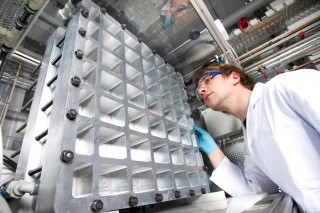
Testing a new stack design for a 5 kWel redox-flow battery with 40 cells and a cell area of 2000 cm2.
To develop a scalable electricity storage unit with an electric power of 100 kWel and a capacity of 1 MWhel, we are working on the stack and system development and the management of redox flow batteries at Fraunhofer ISE. By applying simulation-supported analysis and design of redox flow batteries, we identify optimisation potential at the cell and stack level and use this to further develop the design. Within the “1 MWh Redox-Flow Netzspeicher” project on grid-connected storage, we have developed an optimised cell stack with a power of 5 kWel for use in mini-grid systems or gridconnected storage systems. Cycling efficiency values of above 80% have been achieved at the stack level. Current research is concentrating on further increasing the power and energy density and reducing the production costs of a 5kWel cell stack. | Duration: June 2010 - February 2013
more info -
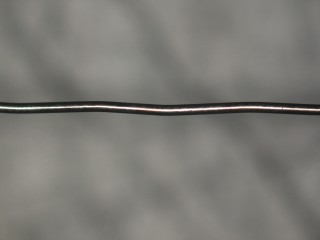
Fig. 1: Microscope image of a structured wire.
Project in the Business Area Photovoltaics; Topic: Silicon Photovoltaics; Field of Work: Feedstock, Crystallization and Wafering; Duration: October 2010 - September 2013
more info -
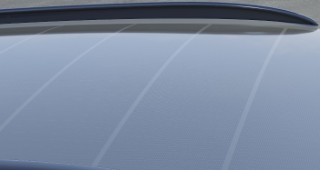
Visualization of a PV car roof with shingled solar cells.
The integration of photovoltaics into existing surfaces, devices and envelopes requires new module concepts and thus module manufacturing processes. Curved PV modules can be used in e-vehicle roofs, for example. The prototype of a curved PV car roof was manufactured at Fraunhofer ISE in 2019. In order to be able to manufacture curved PV modules industrially, an industrial laminator as well as the required processes and module concepts are being developed in the "3D" project. In addition, methods for mechanical and electrical characterization are being developed and tested. Solar cell strings are examined by Magnetic Field Imaging (MFI) and conductive adhesives by Dynamic Mechanical Analysis (DMA). | Duration: 02/2021 - 01/2024
more info -
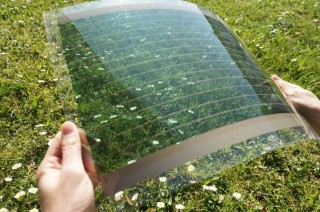
Mock-up of a transparent organic solar module manufactured with a still strongly absorbing organic semiconductor material. In the project, such modules with electrical function and higher transparency are to be manufactured and the technology presented to interested users on the basis of these demonstrators.
Climate change has become a tangible reality in Germany in recent years. Heatwave summers and low precipitation in winters have led to massive problems in agriculture in many places. Protected cultivation under foils is a current trend, causing additional costs and waste problems. In this project, highly transparent organic solar cells will be developed that allow visible light, which is important for plants, to pass through and use the infrared portion to generate electricity. These could make it possible to simultaneously generate the urgently needed solar power for a successful energy and mobility turnaround from the film covers that are intended to protect plants from heavy rain, hail, sunburn and desiccation. | Duration: 09/2021 - 07/2024
more info -

Sintered aluminum fiber material coated with adsorbent material (SAPO-34).
The objective is the development of a heater on zeolite basis with water as operating medium, which based on novel absorption heat exchangers and optimized functionality of evaporator and condenser is significantly more compact and cost-effective than the devices on the market with comparable outputs and an annual COP of over 1.3. Porous materials with good thermal conductivity are of central importance for the development of absorption heat exchangers. A large surface paired with thin sorbent layers (< 100 µm) accelerates the dynamics of the ad- and desorption process. It thus offers a larger potential for a higher power density of the sorption module of the gas heat pump. | Duration: 05/2013 - 04/2017
more info -

In the EU-funded "AI4Cities" project, leading European cities such as Amsterdam, Helsinki and Stavanger are coming together to search for solutions based on artificial intelligence (AI) for decarbonization in the areas of mobility and energy. For many cities, district heating is a central pillar in their decarbonization strategy. Continuous and automated monitoring of district heating substations can ensure energy-efficient and economical operation of district heating networks. With the help of Symvio's software solution, which is being developed in the AI4CITIES project together with Fraunhofer ISE, utilities and clients such as technical municipalities can better monitor and optimize the operation of their district heating connections and thus reduce energy consumption and save CO2. | Duration: 04/2021 - 03/2022
more info -
AI4Grids
AI - based planning and operational management of distribution grids and microgrids for the optimal integration of renewable generators and fluctuating loads in the context of the energy transition.
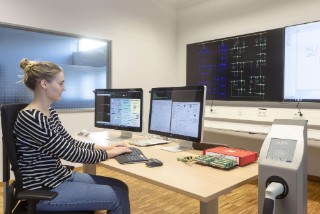
Control room in the Digital Grid Lab of Fraunhofer ISE as a central control point for grid operation with AI processes.
To slow climate change, we need a shift away from fossil energy sources. However, the necessary expansion of renewable energies and the switch to electric cars pose challenges for the power grid: Solar and wind energy feed power into the grid very irregularly, while electricity energy demand is constant or increasing, especially in cities. Nevertheless, new flexible consumers, such as electric cars and heat pumps, can become the solution for the energy transition in interaction with fluctuating renewable generators - through intelligent grid control. | Duration: 09/2020 - 12/2023
more info -
AIIR-Power
AI-assisted design and fabrication of photonic infrared power converters for energy and telecommunication
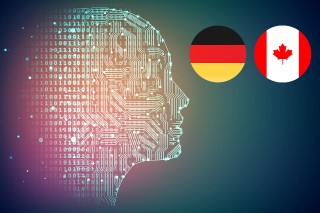
Photonics and optoelectronics are key technologies for the digitalization. The design of corresponding semiconductor devices as well as the modeling of epitaxial processes can still benefit significantly from artificial intelligence (AI) methods in the context of Industry 4.0. Ubiquitous digitization and automation, as well as the Internet of Things, require constant energy and data streams. The emerging technology of photonic power transmission, also known as power-by-light enables power and data transmission to be combined in a single optical link. By using optical telecommunication wavelengths around 1.5 µm, the applications of such power-by-light systems can be extended to remote locations, enabling unlimited remote power supply. AI-assisted approaches to photonic power converter (PPC) design and fabrication are critical for further cross-industry application of photonic power and data transmission. | Duration: 04/2021 - 03/2024
more info -
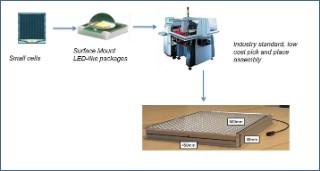
Module and manufacturing concept of the HCPV technology investigated in the ALCHEMI project, aiming at highly efficient, cost effective and compact modules.
In (highly) concentrating photovoltaics ((H)CPV), solar radiation is focused on small but highly efficient solar cells, resulting in high overall efficiencies. Increased efficiency and cost-effective production technologies contribute to further costs reductions. In the ALCHEMI project, a HCPV module is to be developed within a European consortium with central components (primary optics, cell) potentially being provided by German suppliers. The secondary optics are manufactured through procedures established in optoelectronics. Fraunhofer ISE optimizes the design of the two-stage concentrator optics and characterizes the prototypes. The thermal design is also being assessed by Fraunhofer ISE. | Duration: November 2016 - January 2020
more info